<< Previous | Displaying results 3976-4000 of 6772 for "" | Next >>
Reverse of the official identification tag (warrant badge) for the Kriminalpolizei or Kripo, the detective police force of Nazi Germany. It reads Staatliche Kriminalpolizei (State Criminal Police) and identifies the officer's number as 8409.
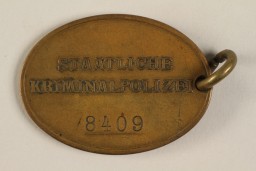
A page from the transcript of the testimony given by Rudolf Höss at the International Military Tribunal at Nuremberg. At the trial, Höss testified about the gassing of Jews of Auschwitz, where he was commandant. He responded in German and communicated through a translator. Testimony dated April 2, 1946.
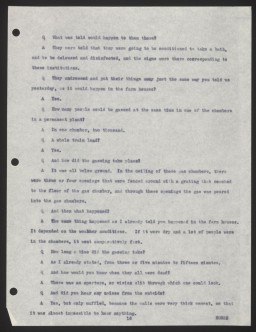
This badge shows the Hitler Youth insignia and Nazi German national symbol superimposed over ring bearing the raised text, "Deutsches/Jugendfest 1936." Beginning in 1933, the Hitler Youth and the League of German Girls had an important role to play in the new Nazi regime. Through these organizations, the Nazi regime planned to indoctrinate young people with Nazi ideology. This was part of the process of Nazifying German society. The aim of this process was to dismantle existing social structures and…
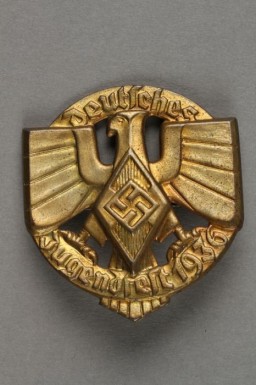
This League of German Girls jacket has two embroidered cloth patches handstitched to the upper left sleeve: a dark triangle displaying the name of the member’s region, South Franconia (Süd Franken), and a Hitler Youth insignia. Beginning in 1933, the Hitler Youth and its organization for girls and young women, the League of German Girls, played an important role in the new Nazi regime. Through these organizations, the Nazi regime indoctrinated young people with Nazi ideology, including antisemitism and…
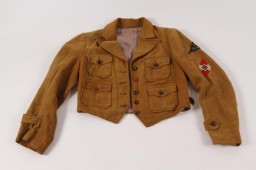
Hitler Youth summer uniform jacket with an armband and insignia designating the regiment and district to which the member belonged. Beginning in 1933, the Hitler Youth and its organization for girls and young women, the League of German Girls, played an important role the new Nazi regime. Through these organizations, the Nazi regime indoctrinated young people with Nazi ideology, including antisemitism and racism. All prospective members of the Hitler Youth had to be "Aryans" and "genetically healthy."…

Hitler Youth knife and case shaped like a military bayonet, with the emblem of the Hitler Youth, emphasizing the paramilitary nature of the organization.
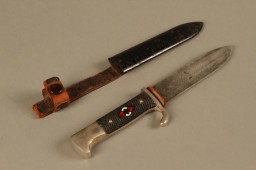
This Hitler Youth proficiency badge would have been awarded for the successful completion of a series of tests measuring physical and ideological proficiency. Success in these tests was rated according to criteria in the Hitler Youth identity document and performance book known as the Leistungsbuch. On this badge, the arrow shape (the tyr-rune) represents the warrior god Tyr. Beginning in 1933, the Hitler Youth and the League of German Girls had an important role to play in the new Nazi regime. Through…
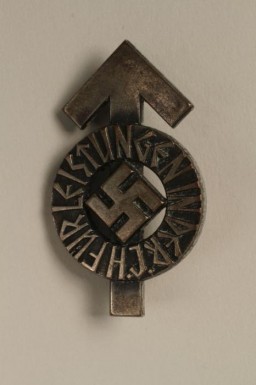
This drawing, titled "L'Attente" [Mother and Son Waiting], was created by German Jewish artist Lili Andrieux (1914-1996) while she was imprisoned in the Gurs internment camp in France in 1940.
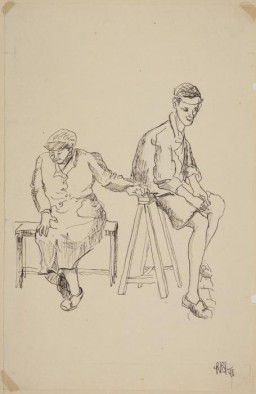
These tiny black, white, gold, and clear glass beads were used by Rachel “Chelly” de Groot from November 1942 to April 1944 and recovered by her brother Louis after the war. Chelly used the beads to make handicrafts. On November 16, 1942, Chelly, then 15, Louis, 13, and their parents Meijer and Sophia left Arnhem and went into hiding after the Dutch police warned them of a raid. Meijer and Sophia hid in Amsterdam while Chelly and Louis moved around to different locations. In summer or fall 1943,…
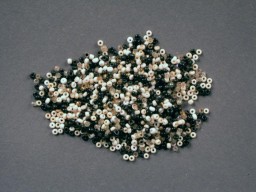
One of the milk cans used by Warsaw ghetto historian Emanuel Ringelblum to store and preserve the secret "Oneg Shabbat" ghetto archives.This milk can, identified as no. 2, was unearthed at 58 Nowolipki Street in Warsaw on December 1, 1950.
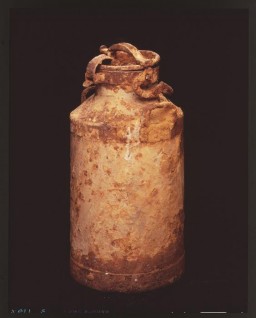
One of the ten metal boxes in which portions of the Ringelblum Oneg Shabbat archives were hidden and buried in the Warsaw ghetto. The boxes are currently in the possession of the Jewish Historical Institute in Warsaw.
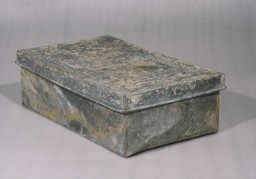
One of the two milk cans in which portions of the Ringelblum Oneg Shabbat archives were hidden and buried in the Warsaw ghetto. The milk cans are currently in the possession of the Jewish Historical Institute in Warsaw.
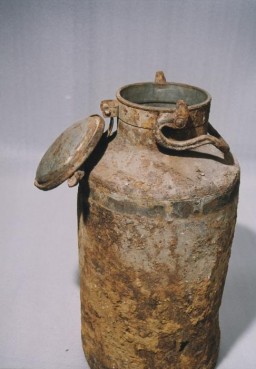
One of the ten metal boxes in which portions of the Oneg Shabbat archive were hidden and buried in the Warsaw ghetto. The boxes are currently in the possession of the Jewish Historical Institute in Warsaw. This view is of an open box without the lid.
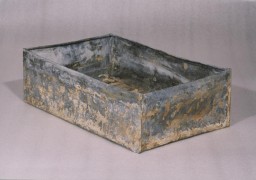
Three of the ten metal boxes in which portions of the Oneg Shabbat archive were hidden and buried in the Warsaw ghetto. The boxes are currently in the possession of the Jewish Historical Institute in Warsaw. In this view the three boxes are stacked on top of one another. The box on top is displayed on its side without the lid.
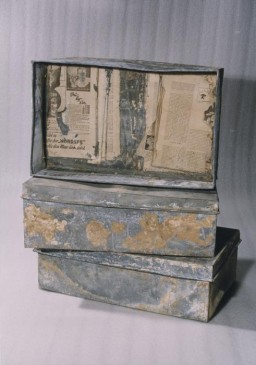
Poster urging young Germans to join the Hitler Youth Landdienst [agricultural service]. It reads "Volunteers to the front! Youth to the land service of the Hitler Youth."

Election poster reading "The People Vote Listing One: Nationalsocialism," 1932-1933

Election poster reading "We workers have awakened: We’re voting National Socialist List 2 ," 1932.
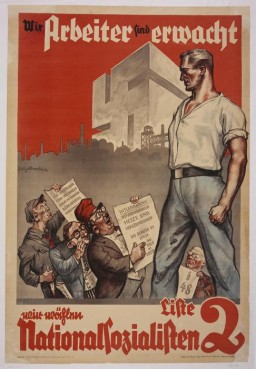
Antisemitic propaganda flyer comparing Jews to diseases. It reads "Tuberculosis Syphilis Cancer are curable ... It is necessary to finish the biggest curse: The Jew!"
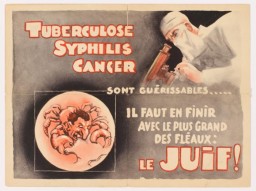
A diagram showing the medical chain of command in the Third Reich, drawn up as evidence for the Doctors Trial. Nuremberg, Germany, December 1946.
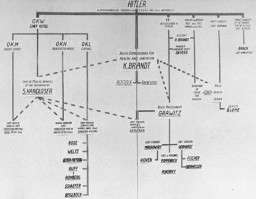
Military entry permit allowing Jadwiga Dzido to travel through occupied Germany to appear as a witness in the Medical Case trial at Nuremberg. 1946.
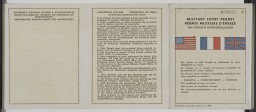
Reverse side of a military entry permit allowing Jadwiga Dzido to travel through occupied Germany to appear as a witness in the Medical Case trial at Nuremberg. 1946.
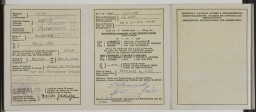
Cover of a mimeographed program booklet distributed at the International Military Tribunal at Nuremberg.
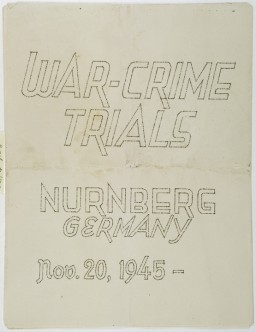
Floor plan of the courtroom. The plan appeared in a mimeographed program booklet distributed at the International Military Tribunal at Nuremberg. 1945.
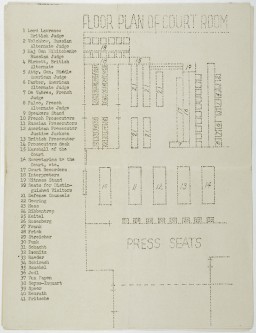
First page of a list of defendants at the International Military Tribunal at Nuremberg. This material appears in a mimeographed program booklet distributed at the IMT. This page includes: Hermann Göring, Rudolf Hess, Joachim von Ribbentrop, and Alfred Rosenberg, along with brief biographical information for each.
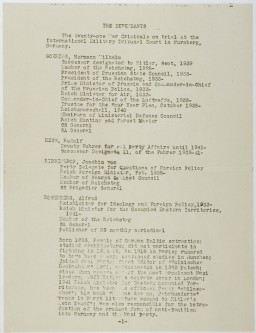
Third page of a list of defendants at the International Military Tribunal at Nuremberg. This material appears in a mimeographed program booklet distributed at the IMT. This page includes: Julius Streicher, Wilhelm Keitel, Walter Funk, and Hjalmar Schacht., along with brief biographical information for each.
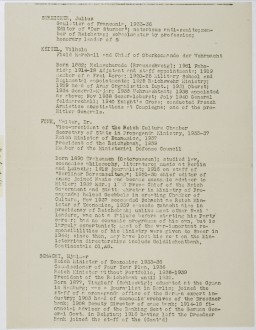
We would like to thank Crown Family Philanthropies, Abe and Ida Cooper Foundation, the Claims Conference, EVZ, and BMF for supporting the ongoing work to create content and resources for the Holocaust Encyclopedia. View the list of donor acknowledgement.